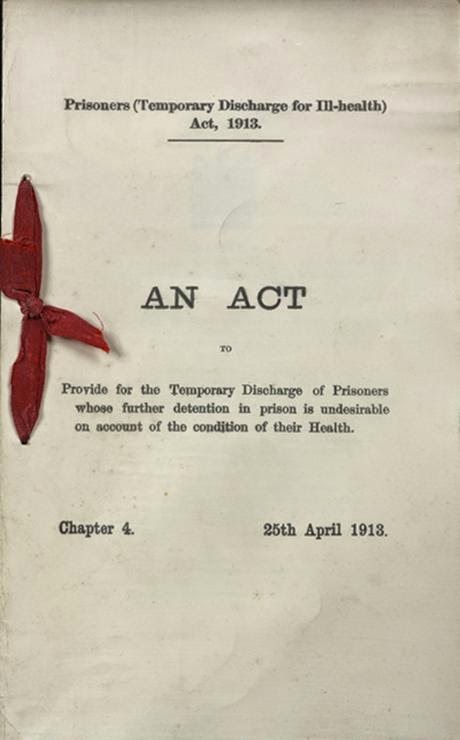Hunger Strikes and The Cat and Mouse Act
The first arrests came about in 1905 when two active members of the suffrage movement, namely Christabel Pankhurst and Annie Kenney, interrupted a political meeting between Sir Edward Grey and the future British Prime Minister Winston Churchill. The two men were asked 'if they believed women should have the right to vote' (Trueman, 2013) there was no response from either man.
Due to their disruptive actions, both women were promptly thrown out of the meeting and arrested for causing an obstruction and also for a technical assault on a police officer (Purvis, 2009).
The Hunger strike came about from being granted the status of political prosioner (Purvis, 2009) and as a backlash to this lack of acknowledgement, the hunger strike was put into action. The Government did not want the Suffragettes to die in prison and be seen as martyrs by the public so they introduced force feeding (Trueman, 2013).
On 5 July 1909, the imprisoned suffragette Marion Wallace Dunlop, a sculptor and illustrator, went on hunger strike. A member of the Women's Social and Political Union (WSPU), founded by Emmeline Pankhurst in 1903 to campaign for the parliamentary vote for women, she had been sent to Holloway prison for printing an extract from the bill of rights on the wall of St Stephen's Hall in the House of Commons. In her second division cell, Wallace Dunlop refused all food as a protest against the unwillingness of the authorities to recognise her as a political prisoner, and thus entitled to be placed in the first division where inmates enjoyed certain privileges. (Purvis, 2009)
Of her Hunger strike, Dunlop claimed it was 'a matter of principle, not only for my own sake but for the sake of others who may come after me … refusing all food until this matter is settled to my satisfaction' (Purvis, 2009).
The Hunger strike came about from being granted the status of political prosioner (Purvis, 2009) and as a backlash to this lack of acknowledgement, the hunger strike was put into action. The Government did not want the Suffragettes to die in prison and be seen as martyrs by the public so they introduced force feeding (Trueman, 2013).
On 5 July 1909, the imprisoned suffragette Marion Wallace Dunlop, a sculptor and illustrator, went on hunger strike. A member of the Women's Social and Political Union (WSPU), founded by Emmeline Pankhurst in 1903 to campaign for the parliamentary vote for women, she had been sent to Holloway prison for printing an extract from the bill of rights on the wall of St Stephen's Hall in the House of Commons. In her second division cell, Wallace Dunlop refused all food as a protest against the unwillingness of the authorities to recognise her as a political prisoner, and thus entitled to be placed in the first division where inmates enjoyed certain privileges. (Purvis, 2009)
Of her Hunger strike, Dunlop claimed it was 'a matter of principle, not only for my own sake but for the sake of others who may come after me … refusing all food until this matter is settled to my satisfaction' (Purvis, 2009).
The Government were extremely embarrassed by the situation of force feeding because of the severity of the tactics used to force feed the women, 'The forcible feeding of women was a brutal and life-threatening procedure conducted against the wishes of the "patient". The hunger striker was held down on a bed by wardresses or tied to a chair which they tipped back. Then a rubber tube was either forced up the nose or down the throat and into the stomach. The latter method was particularly painful because a steel gap was pushed into the mouth and screwed open, as wide as possible. Tissue in the nose and throat was nearly always damaged, while sometimes the tube was accidentally inserted into the windpipe, causing food to enter the lungs and endangering life. This invasion of the body, accompanied by overpowering physical force, suffering and humiliation made many women feel they had been raped, with the words "violation" or "outrage" being commonly used' (Purvis, 2009)
The Cat and Mouse Act
http://www.parliament.uk/about/living-heritage
The government sought to deal with the problem of hunger striking suffragettes with the 1913 Prisoners (Temporary Discharge for Ill-Health) Act, commonly known as the Cat and Mouse Act.
This Act allowed for the early release of prisoners who were so weakened by hunger striking that they were at risk of death. They were to be recalled to prison once their health was recovered, where the process would begin again. (Parliament.UK, 2014)

No comments:
Post a Comment